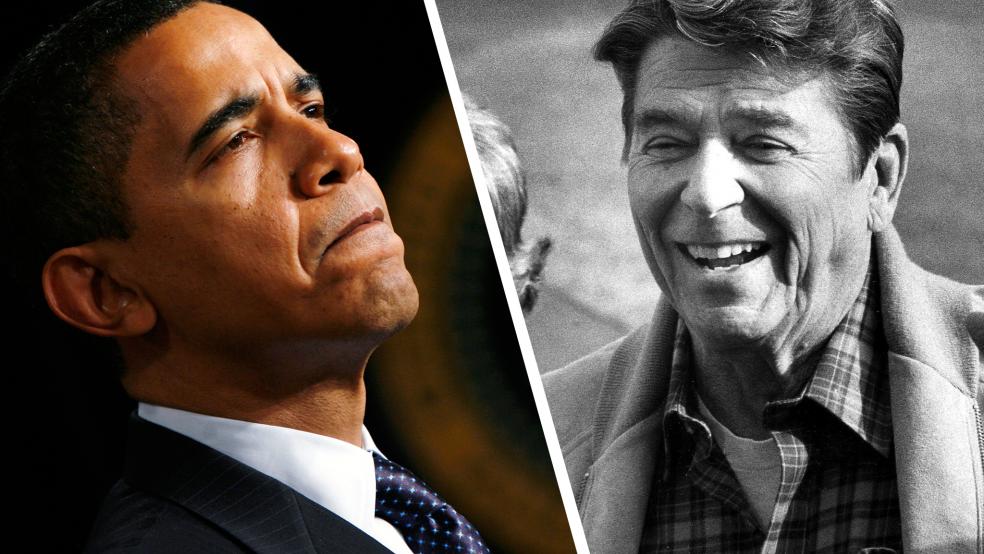In 1982, Ronald Reagan found himself in political trouble over his economic policies, which aimed to end a decade of stagnation and runaway inflation while improving America’s military position against the Soviets in the Cold War. While his regulatory policies had brought rapid declines in energy costs to consumers, the US economy tipped back into a double-digit inflation.
Democrats spent the midterms of Reagan’s second year as President arguing that voters needed to correct his extreme “Reaganomics,” and threatened to unravel all of the efforts Reagan had already made. In response, Reagan went on the campaign trail, telling voters that they should “stay the course” and allow his policies enough time to work.
Related: Obama’s SOTU Proposals—Winners and Losers
Reagan ended up losing 27 seats in the House, which Democrats had controlled anyway. He fought to a draw in the Senate and protected GOP control in the upper chamber. More importantly, Reagan had won breathing space in terms of public opinion, while betting the final two years and his re-election prospects in 1984 on economic success.
The bet paid off with a massive economic expansion that added almost 7.2 million jobs in the two years between the midterms and Reagan’s re-election in 1984. By the time Reagan left office in January 1989, the American economy would add 16 million jobs and raise the percentage of the population in the workforce from 63.9 percent to 66.5 percent.
Fast forward thirty-two years, and the contrast is striking. Once again, we have a President asking America to stay the course, only this time we have almost five years of failure already on the record. And yet, rather than offer any hint of recognition of the failure of his policies, Barack Obama offered a laundry list of policies recycled from a litany of failures.
Related: The Mobility Myth and Other Income Inequality Surprises
The White House wanted to focus on income inequality in President Obama’s State of the Union speech, but with more than 90 percent of Americans wanting to hear about job creation, Obama’s address to the joint session of Congress ended up leaning more heavily in that direction. In order to make the case for success and for his own version of “stay the course,” though, the President had to remove a great deal of context from his metrics.
First, Obama claimed that his policies had resulted in “more than eight million new jobs our businesses have created over the last four years.” Strictly speaking, this is close to the right number for that specific time frame, which is actually 7.5 million from December 2009 to December 2013.
That ignores the job losses that occurred between the start of the technical recovery in June 2009 despite the passage of the $800 billion stimulus bill in early February 2009, chock-full of promised “shovel-ready jobs” and other measures that would prevent the unemployment rate from hitting 8 percent.
From the start of Obama’s economic policies to the latest figures from the Bureau of Labor Statistics, we have only added 4.77 million jobs. Spread over 55 months, this averages less than 87,000 jobs added a month – far below the 150,000 per month needed to keep pace with population growth.
Related: Obama’s Health Care Promise Named “Lie of the Year”
Washington Post fact-checker Glenn Kessler took Obama to task on this metric, and made an even more stark comparison. “[T]he data also show that since the start of his presidency, about 3.2 million jobs have been created,” Kessler wrote after the speech, “and the number of jobs in the economy still is about 1.2 million lower than when the recession began in December 2007.”
He also flagged an attempt to take credit for a growing manufacturing sector by noting that “that the number of manufacturing jobs is still 500,000 fewer than when Obama took office,” with 1.7 million fewer than at the start of the Great Recession.
Next, Obama took credit for lowering the unemployment rate to 6.7 percent, “the lowest unemployment rate in five years,” but that also misses critical context. The jobless rate relies on the workforce remaining constant, but it has sharply declined since the recovery began.
In June 2009, the workforce participation rate was 65.7 percent, the same as it was when Obama took office. Even in February 2010, the rate was 64.9 percent, the same as when Reagan gave his sixth-year State of the Union speech. Today that figure is at 62.8 percent, the lowest level since 1978. More people have left the workforce than have found jobs in the Obama presidency, even if just confined to the recovery period of the last 55 months.
Related: The Surprising Reason College Grads Can’t Get a Job
Again, the contrast is stark. Even in the first two difficult years of the Reagan presidency, unemployment spiked but people stayed in the workforce. The participation rate in Reagan’s first term started at 63.9 percent, dipped to 63.5 percent, and ended up at 64.5 percent by the 1984 election before the massive growth of the workforce in his second term. Obama, who ironically ran on “hope and change,” has produced more hopelessness in five years than Reagan or even George W. Bush managed to generate.
It’s this dogged refusal to acknowledge failure that produces Obama’s well-worn litany of short-term gimmicks as his economic policies. What exactly were his job-creation proposals? Well, his leading proposals to “expand opportunity for more American families” was the First Lady’s Let’s Move effort on childhood obesity, a committee to urge people to hire more veterans, and a conference to address “inequality in access to higher education.”
Obama offered a vague endorsement of tax reform to incentivize business investment and “insourcing” of jobs from overseas. Ironically, Obama made this pitch after the White House convinced retiring Senate Democrat Max Baucus to abandon his effort to find bipartisan tax reform to become the next Ambassador to China. The same day Obama paid lip service to that tax reform, Baucus told the Senate Foreign Relations Committee that he was “no real expert on China” when he couldn’t answer basic questions on acute diplomatic issues in the region.
Related: State of Foreign Policy—Not a Sharp Picture
Obama did mention energy as one opportunity, calling natural gas a “bridge fuel,” but insisting that he would block carbon emissions in the future. On top of that, Obama proposed spending more money on infrastructure –- the very same “shovel-ready jobs” policy that the stimulus funded. Its failure, in light of the lack of job creation and declining participation in the workforce, could hardly be more emphatic.
However, Obama still has no Plan B after five years of stagnation. As a result of that refusal to recognize reality, we end up enduring yet another State of the Union speech filled with wish lists of government intervention when we need to get government out of the way to generate real job expansion – as Reagan did in his first term.
We should stop staying the course. We need a better captain – one with a lot more experience at the helm, or at the very least one who recognizes failure and is smart enough not to keep navigating into the same swamp.
Top Reads from The Fiscal Times:






